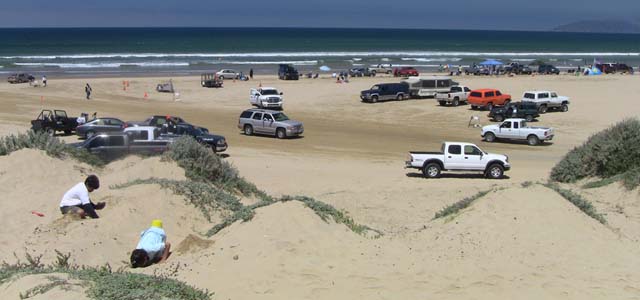APCD hearing board approves Oceano Dunes dust agreement
May 1, 2018

The San Luis Obispo County Air Pollution Control District (APCD) Hearing Board on Monday approved a hotly contested agreement between the APCD and California state parks over reducing dust flows coming from the Oceano Dunes. [Cal Coast Times]
State parks’ deal with the APCD will lead to the closure of portions of the Oceano Dunes to off-road vehicles in order to create islands of vegetation within the park. Presently, there are 186 acres of fenced vegetation islands on the dunes, according to a map circulated by the APCD.
The agreement requires particulate matter emissions to be reduced by 50 percent. The hearing board previously rejected a negotiated deal between the APCD and state parks that would have sought to reduce emissions by 30 percent.
Other conditions in the newly approved agreement include the formation of a scientific advisory group. The group is required to meet at least once a year to discuss emission reduction efforts.
For years, the APCD and Nipomo Mesa residents have clashed with state parks and off-road vehicle riders over Oceano Dunes dust flows. In 2011, the air district adopted the Oceano Dunes dust rule, which requires state parks to reduce the amount of particulate matter blowing from the dunes off-roading area or face fines of $1,000 per day.
In adopting the regulations, the APCD relied on contested studies that concluded off-road vehicles on the dunes were causing pollution on the Nipomo Mesa. The APCD also claimed that crystalline silica, which commonly appears in nature as quartz, made up a significant portion of the dust blowing onto the Nipomo Mesa and that it created a cancer risk for residents. However, the APCD did not release the results of its silica testing.
Meanwhile, state parks conducted its own crystalline silica tests and did release the results. State parks’ tests listed crystalline silica levels as below the detection limit.
Additionally, a 2018 report by the Scripps Institution of Oceanography at UC San Diego found that much of the dust blowing on the mesa is biological from the ocean and not the sand dunes.
On Monday, Nipomo Mesa residents and supporters of off-roading at the Oceano Dunes packed the SLO County Board of Supervisors chambers, where the APCD hearing board met. The deal between the APCD and state parks was met with opposition from both sides.
Nipomo residents argued the agencies involved are not doing enough to reduce emissions and air pollution on the Mesa. Supporters of off-road activity, who oppose further closures of riding areas, argued the APCD is continuing to use faulty science.
The hearing board then voted 4-1 to approve the agreement. The deal must now go before the California Coastal Commission before it is implemented by state parks.






The comments below represent the opinion of the writer and do not represent the views or policies of CalCoastNews.com. Please address the Policies, events and arguments, not the person. Constructive debate is good; mockery, taunting, and name calling is not. Comment Guidelines